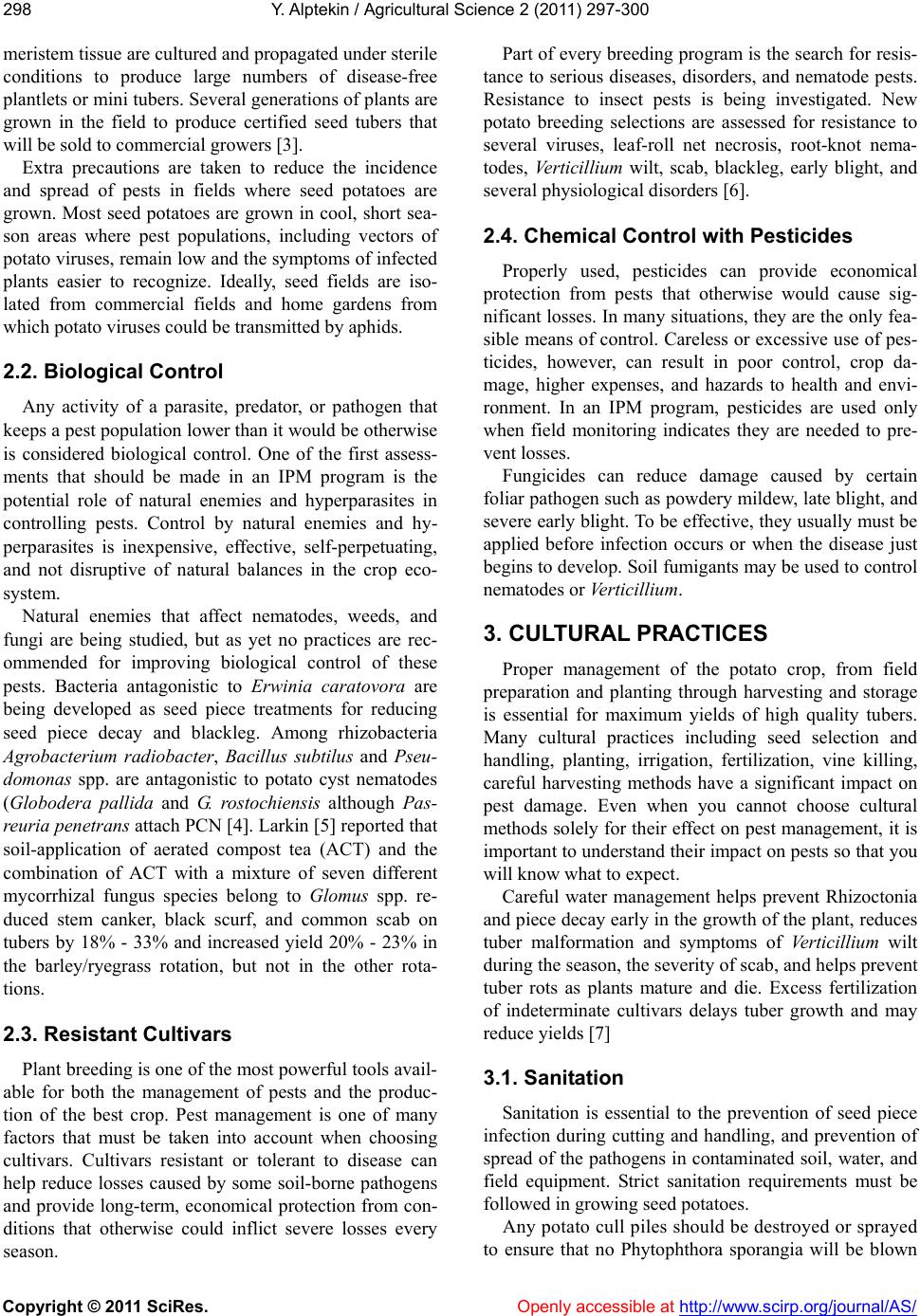
Y. Alptekin / Agricultural Science 2 (2011) 297-300
Copyright © 2011 SciRes. Openly accessible at http://www.scirp.org/journal/AS/
298
meristem tissue are cultured and propagated under sterile
conditions to produce large numbers of disease-free
plantlets or mini tubers. Several generations of plants are
grown in the field to produce certified seed tubers that
will be sold to commercial growers [3].
Extra precautions are taken to reduce the incidence
and spread of pests in fields where seed potatoes are
grown. Most seed potatoes are grown in cool, short sea-
son areas where pest populations, including vectors of
potato viruses, remain low and the symptoms of infected
plants easier to recognize. Ideally, seed fields are iso-
lated from commercial fields and home gardens from
which potato viruses could be transmitted by aphids.
2.2. Biological Control
Any activity of a parasite, predator, or pathogen that
keeps a pest population lower than it would be otherwise
is considered biological control. One of the first assess-
ments that should be made in an IPM program is the
potential role of natural enemies and hyperparasites in
controlling pests. Control by natural enemies and hy-
perparasites is inexpensive, effective, self-perpetuating,
and not disruptive of natural balances in the crop eco-
system.
Natural enemies that affect nematodes, weeds, and
fungi are being studied, but as yet no practices are rec-
ommended for improving biological control of these
pests. Bacteria antagonistic to Erwinia caratovora are
being developed as seed piece treatments for reducing
seed piece decay and blackleg. Among rhizobacteria
Agrobacterium radiobacter, Bacillus subtilus and Pseu-
domonas spp. are antagonistic to potato cyst nematodes
(Globodera pallida and G. rostochiensis although Pas-
reuria penetrans attach PCN [4]. Larkin [5] reported that
soil-application of aerated compost tea (ACT) and the
combination of ACT with a mixture of seven different
mycorrhizal fungus species belong to Glomus spp. re-
duced stem canker, black scurf, and common scab on
tubers by 18% - 33% and increased yield 20% - 23% in
the barley/ryegrass rotation, but not in the other rota-
tions.
2.3. Resistant Cultivars
Plant breeding is one of the most powerful tools av ail-
able for both the management of pests and the produc-
tion of the best crop. Pest management is one of many
factors that must be taken into account when choosing
cultivars. Cultivars resistant or tolerant to disease can
help reduce losses caused by some soil-borne pathogens
and provide long-term, economical protection from con-
ditions that otherwise could inflict severe losses every
season.
Part of ever y breeding program is the search for resis-
tance to serious diseases, disorders, and nematode pests.
Resistance to insect pests is being investigated. New
potato breeding selections are assessed for resistance to
several viruses, leaf-roll net necrosis, root-knot nema-
todes, Verticillium wilt, scab, blackleg, early blight, and
several physiological diso rd er s [6] .
2.4. Chemical Control with Pesticides
Properly used, pesticides can provide economical
protection from pests that otherwise would cause sig-
nificant losses. In many situations, they are the only fea-
sible means of control. Careless or excessive use of pes-
ticides, however, can result in poor control, crop da-
mage, higher expenses, and hazards to health and envi-
ronment. In an IPM program, pesticides are used only
when field monitoring indicates they are needed to pre-
vent losses.
Fungicides can reduce damage caused by certain
foliar pathogen such as powdery mildew, late blight, and
severe early blight. To be effective, they usually must be
applied before infection occurs or when the disease just
begins to develop. Soil fumigants may be used to control
nematodes or Verticillium.
3. CULTURAL PRACTICES
Proper management of the potato crop, from field
preparation and planting through harvesting and storage
is essential for maximum yields of high quality tubers.
Many cultural practices including seed selection and
handling, planting, irrigation, fertilization, vine killing,
careful harvesting methods have a significant impact on
pest damage. Even when you cannot choose cultural
methods solely for their effect on pest management, it is
important to understand their impact on pests so that you
will know what to expect.
Careful water management helps prevent Rhizoctonia
and piece decay early in the growth of the plant, reduces
tuber malformation and symptoms of Verticillium wilt
during the season, the severity of scab, and helps prevent
tuber rots as plants mature and die. Excess fertilization
of indeterminate cultivars delays tuber growth and may
reduce yields [7]
3.1. Sanitation
Sanitation is essential to the prevention of seed piece
infection during cutting and handling, and prevention of
spread of the pathogens in contaminated soil, water, and
field equipment. Strict sanitation requirements must be
followed in growing seed potatoes.
Any potato cull piles shou ld be destroyed or sprayed
to ensure that no Phytophthora sporangia will be blown